Easy Project Schedule and Time Management Guide

Project schedule and time management are not just tasks but skills that can help your projects succeed. This guide provides you with the information and tools needed to navigate the complexity of project management with ease. We shall explore the basic principles, the essence of cautious scheduling, and how to establish methods that will automate your operations and boost productivity. Through grasping these principles, you can ensure timely completion of projects, optimal resource usage, and better teamwork among employees.
Statistics reveal that effective project scheduling can get teams complete tasks 30% faster than sloppy time management strategies. According to studies, about 70% of project managers believe that a good schedule can save significant project expenses.
In today’s highly competitive business environment, effective project schedule and time management is even more important. Time is money, as the saying goes, in the project management field. Implementing the practices outlined in this guide will not only increase productivity but also improve stakeholder satisfaction and ultimately drive the success of your projects.
Table of Contents
What is Time and Project Schedule Management?
Project time management and scheduling is the planning, execution, and control of the time allocated to various activities and tasks in a project. It ensures that every phase of a project is completed within deadlines and resources set.
Through the formulation of a structured project schedule and time management that breaks down the project into smaller pieces, teams can keep their progress under control and efficiently minimize delays.
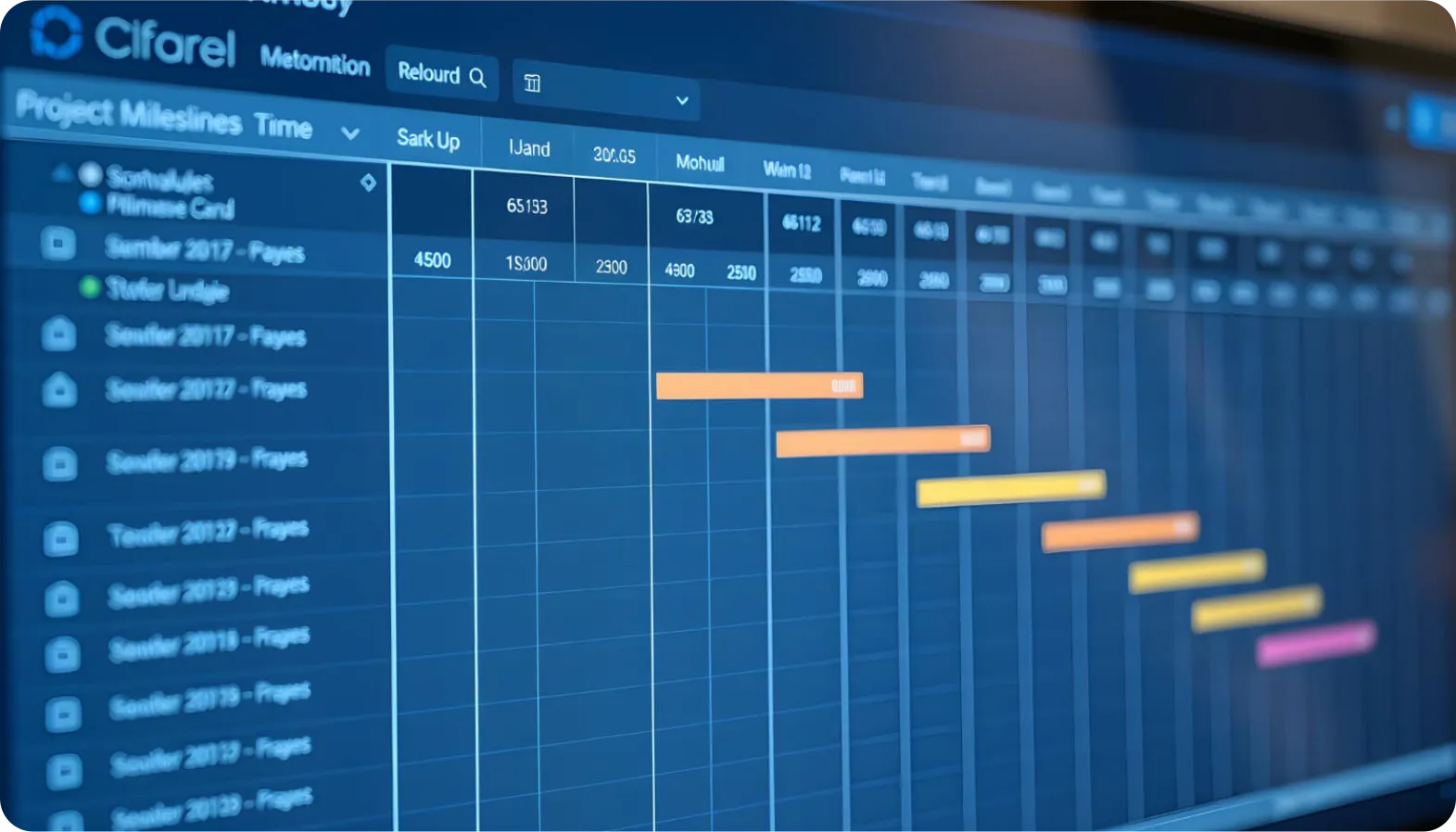
On that premise, project time management also entails task prioritization and organization. Project time management institutes a system to implement goal, deadline, and task establishment, which brings everyone on the same level.
Since projects have numerous facets and numerous moving parts, having an orchestrated plan is paramount to minimizing risks and ensuring team accountability.
Importance of Project Schedule and Time Management in Project Management
The importance of project schedule and time management cannot be overstated. Effective scheduling is directly associated with the failures or successes of project deliveries.
By keeping tight control over time, project managers can foresee bottlenecks, anticipate resource needs, and make schedule adjustments without undermining project objectives.
Good project time management not only means improved project outcomes but also makes employees’ life easier with better work-life balance. In such cases, team members adhering to planned roadmaps have better job satisfaction and morale, potentially reflecting and augmenting the output quality delivered.
This balance contributes to improved cooperative efforts and, ultimately, provides long-term working relationships.
Core Concepts of Project Schedule and Time Management
At the heart of project schedule and time management are several basic principles that govern its practice. They include:
- Milestones Setting: Establishing clear, measurable goals/ milestones of the project. These are the Key performing Indicators (KPIs)
- Task Prioritization: Sequencing the tasks according to urgency and impact.
- Resource Allocation: Allocating appropriate resources (Manpower, Costs, Material) to appropriate activities at appropriate times.
- Monitoring and Control: Regular monitoring to catch problems early.
By mastering these principles, teams become more efficient, respond quickly to changes, and become effective performers in general and hence, the projects are completed on schedule and on budget.
The Seven Main Processes in Project Time Management
Below are the main components while scheduling your projects. As a case study, we have used Oracle’s Primavera P6 to show the different components of the schedule.
1. Planning & Creating a WBS (Work Breakdown Structure)
At this initial stage, the project manager outlines how he is going to schedule the project through proper planning and defining a proper work breakdown structure (WBS). The schedule includes the processes, tools, and techniques to implement project schedule and time management. The intention is to define the Project schedule and time management method, including setting the policies that will dictate how the project will be performed.
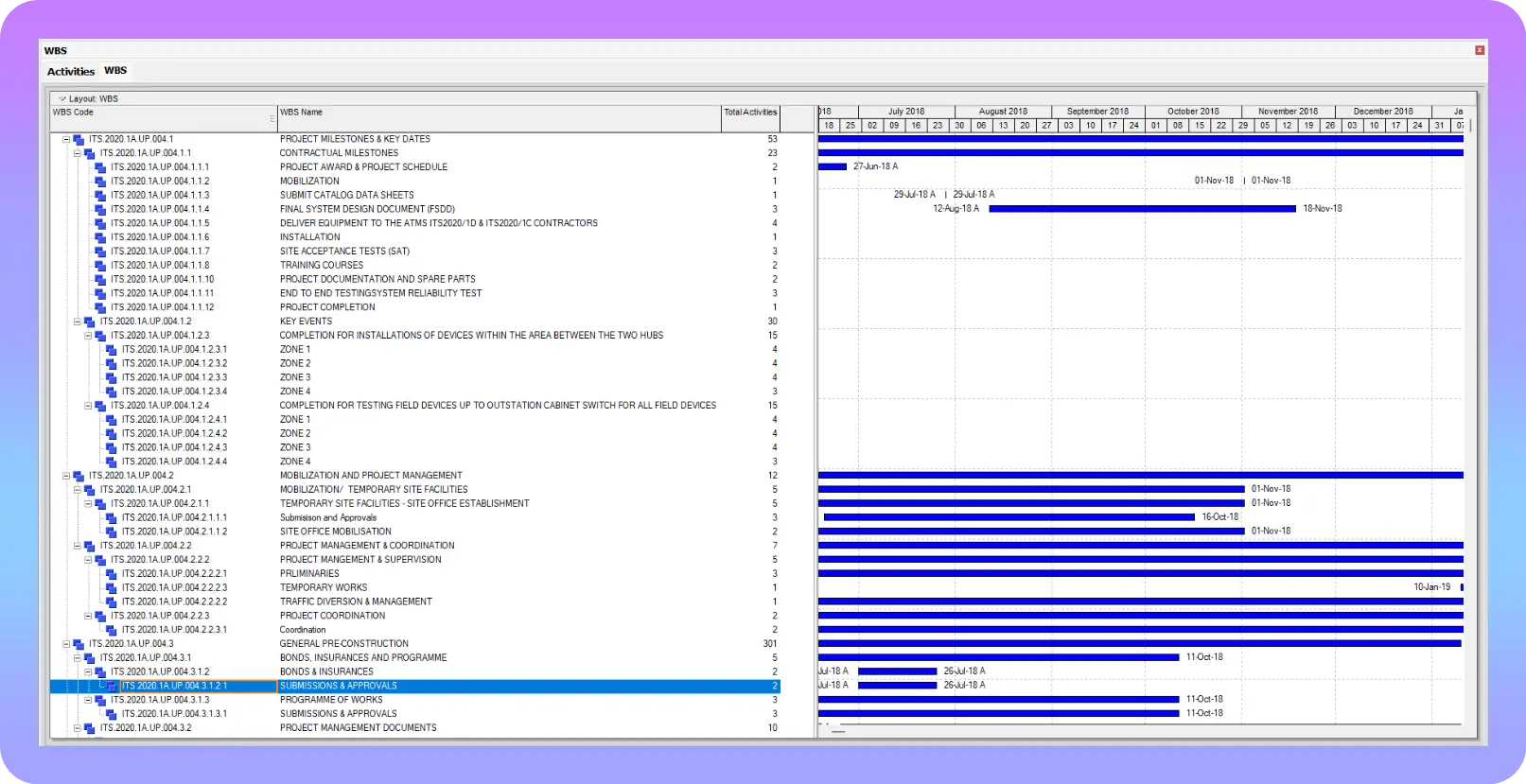
By establishing this plan initially, groups can present clear expectations, make communication easier, and align efforts from the beginning. This stage sets a foundation for managing time efficiently throughout the project life cycle.
2. Define Activities
Following the establishment of the planning and Work breakdown structure (WBS), the next step is to establish the activities that must be achieved to complete the project. Here, the project deliverables are broken down into individual, manageable tasks.
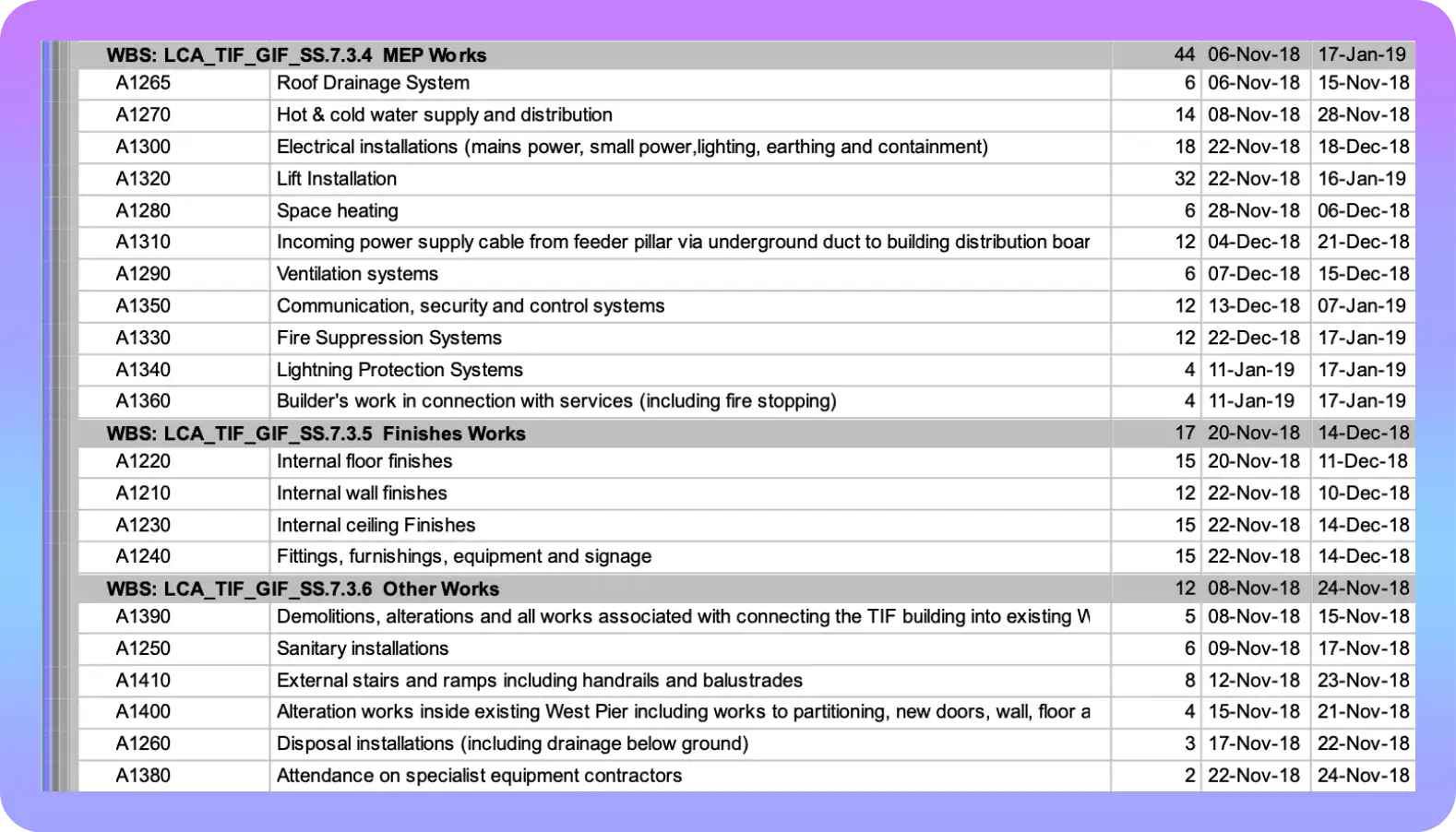
Estimating activities makes it easier to assign responsibility, estimate time, and conceptualize the overall project flow. It is essential to be accurate here so that no activity is omitted later on, causing delays.
Tip: Insert only those activities that are inspectable. Do not increase your number of activities unnecessary just to make your schedules big.
3. Sequence Activities
Sequencing is the determination of the order in which activities are to be executed. Sequencing considers interactivity dependencies; some activities can be started only after others are finished. We structure dependencies (activity relationships) in two ways; one is predecessor dependency (relationship with an activity before the current activity), second is Successor dependency (relationship of the current activity with the next activity).

There are certain types of dependencies (relationships) to be considered while creating sequencing i.e., SS (start to start activities), FS (Finish to start activities), FF (Finish to finish activities), and SF (Start to finish activities).
Proper sequencing of activities prevents overlap and conflict of resources, making workflow simpler. It allows project managers to achieve the critical path of the project so that it is delivered on schedule.
4. Estimate Resources
Resource estimation is the process of determining what resources (human, material, Costs.) are required to complete each task. Effective project schedule and time management relies on proper resource allocation to have the right skills and equipment available when required.
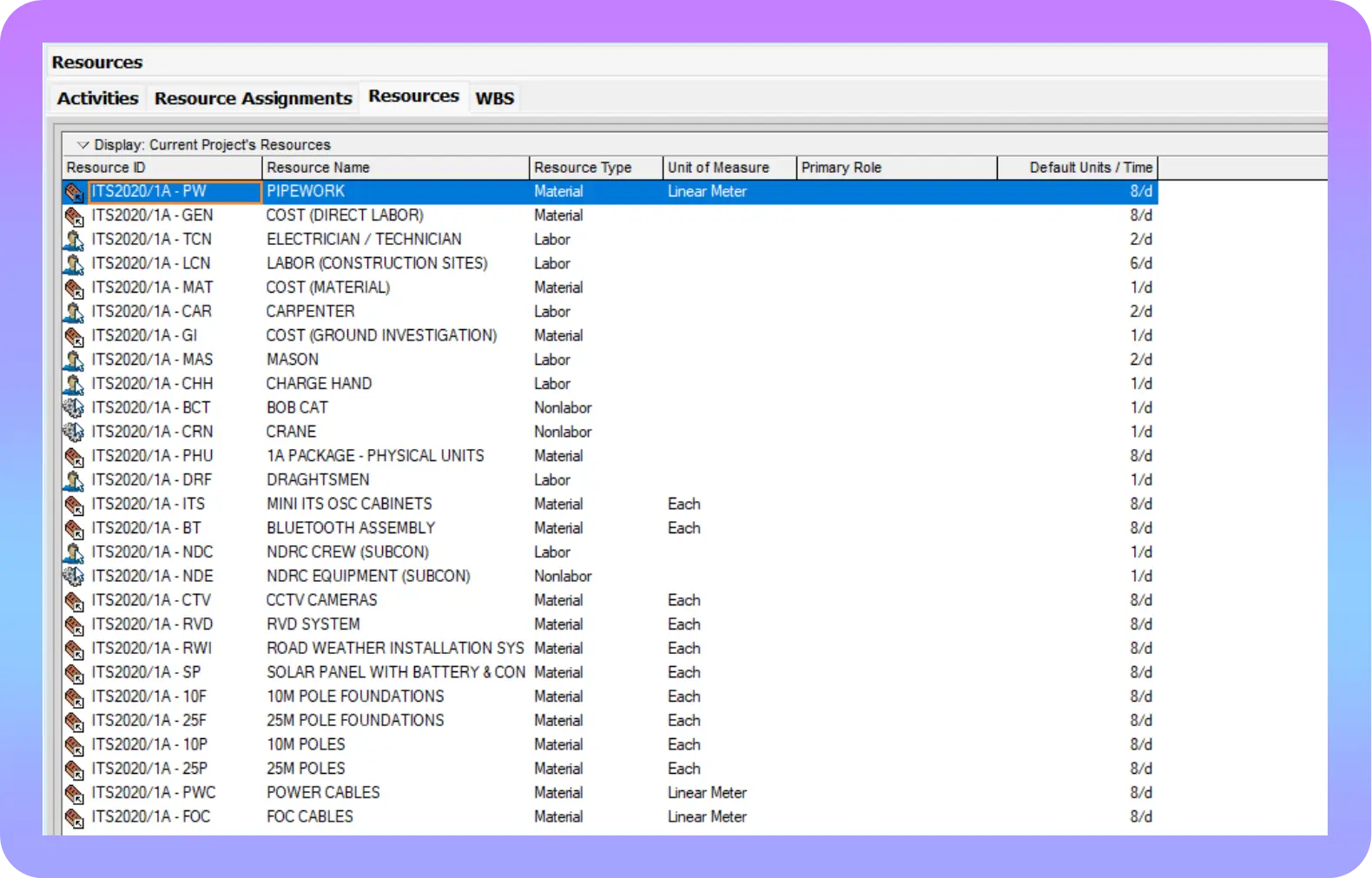
This approximation assists in planning budgets and can signal whether additional resources are necessary, which will then affect project timelines.
Tip: Always use direct manpower while assigning resources to an activity. Reason is that the indirect manpower e.g., Project manager, team leads, engineers etc. come under the project management part of the project which comes directly under the cost as a resource.
5. Estimate Durations
Here, project managers estimate the time required for every task. Proper duration estimation depends on historical data and the intricacy of tasks themselves.
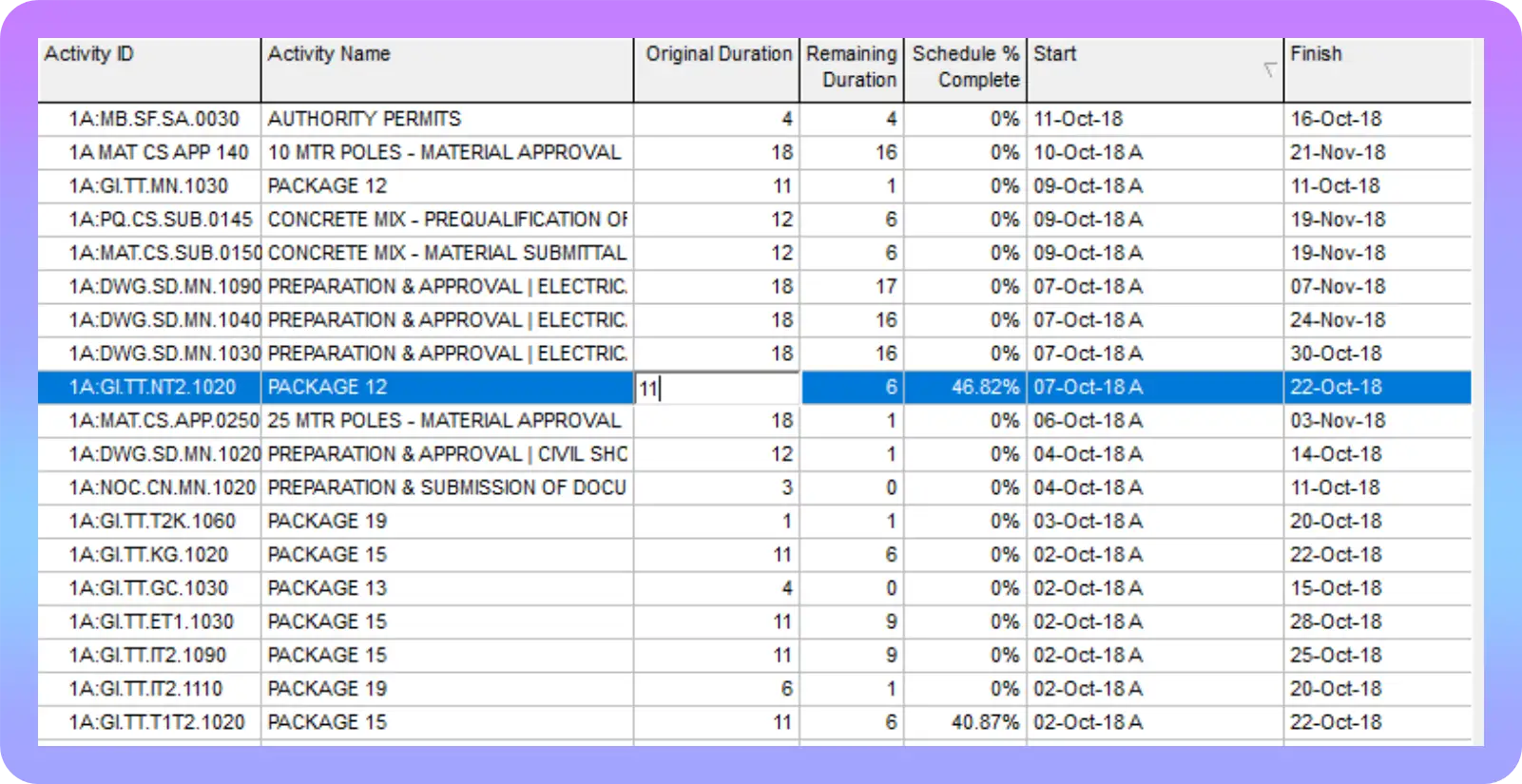
Underestimation can lead to stress and missing deadlines, while overestimation can lead to inefficient use of resources. This step thus requires careful consideration and analysis.
Tip: For the best of the critical path standards, always consider breaking down of activities in such a manner that each activity does not go beyond 28 days of time period. Reason behind this is to maintain proper float within your time schedules.
6. Develop the Project Schedule
Having analyzed and added up all previous information, it’s now time to develop the project schedule and time management. This is the step of adding up all activities, their sequence, resources, and estimated duration into a coordinated timeline.

A graphical display like a Gantt chart can help convey the schedule to stakeholders clearly. A successful project schedule and time management aligns everyone on objectives and due dates, enabling accountability.
Tip: The final schedule should not have any loose relationship (Open ended relationship). To check that, use log file when scheduling your schedule.
7. Control the Schedule
The final process is monitoring the project’s progress against the schedule that has been established. This allows variances to be identified and make the changes necessary to continue with the planned progress.
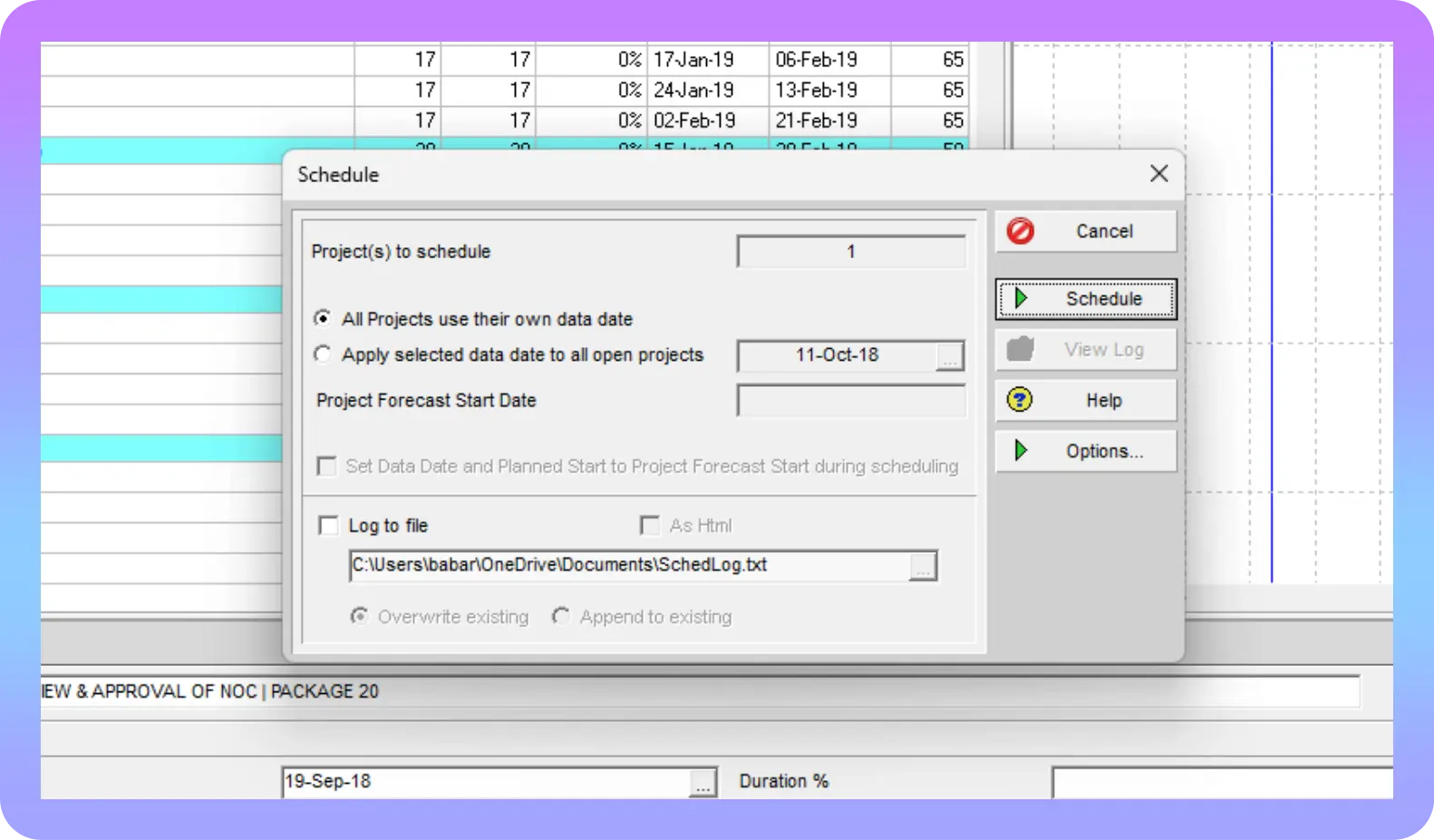
Periodic checking and maintenance not only ensure the project stays on track with its goals but can identify issues before they are critical, allowing proactive action.
Best Project Time Management Strategies
Below are some of the best project time management strategies which we have discovered through the years:

1. Communicate Effectively
Effective project schedule and time management relies on communication. Establish clear lines of communication so everyone knows their role, responsibility, and schedule.
Utilizing tools like Slack or Microsoft Teams can aid in timely updates and discussion. Regular check-ins and updates facilitate transparency and preclude confusion.
2. Task Segmentation and Task Delegation
Task segmentation stimulates better productivity, reducing the tasks as less overwhelming. Assign different tasks to team members based on their expertise to bring accountability and optimize efficiency.
Delegation not only distributes workload but also empowers team members, fostering their professional growth while providing project momentum.
3. Prioritize Work Based on the 80/20 Rule
The 80/20 Rule or Pareto Principle is a principle stating that 80% of outcomes come from 20% of activities. In project management, find out which tasks have the most impact—this will structure effort and conserve resources.
Prioritizing high-impact activities will get you most results and complete the most important deadlines without over-working your team.
4. Use Project Management Tools
By integrating project management software like Oracle Primavera P6, Microsoft Project, Asana, or Trello, task management can be made effective. The products typically consist of elements of Gantt charts, task assigning, and the ability to create reports that support achieving effective scheduling and time management.
Utilizing the products not only assists with organization but also collaboration among the team since the products provide one platform for the project to give updates and has resources.
5. Manage and Schedule Meetings Effectively
Time management should be effective even in meetings. Rationalize the meetings by conducting proper agendas, staying on topic, and following allocated time slots.
Review the effectiveness of meetings periodically and take inputs on how to improve from the members of the team. Less can be more at times; an informal sync can sometimes take the place of formal meetings and yield better outcomes.
6. Remain Flexible and Adapt to Changes
In project management, change is the norm, not the exception. Being flexible and adaptable means your team can switch when necessary, whether due to shifting deadlines or unexpected resource changes.
Having contingency plans in place makes teams transition through interruptions smoothly and save themselves unnecessary stress.
How to Create a Project Schedule & Time Management Plan Using Writegenic AI
We know that it is very tough and time-consuming scenario when we prepare a document manually, therefore in Writegenic AI we have designed a specially trained AI algorithm which generates a draft project schedule & Time Management Plan within minutes. It gives you an overview to the activities to be scheduled, eliminates the human errors and saves plenty of time.
Below steps will help you to develop a Project Schedule & Time Management Plan using Writegenic AI in 3 easy steps under less than 5 minutes.
Step 1: Open project schedule and time management tool
First, you need to register on WriteGenic AI. It’s relatively simple to join and is based on a form to complete with some data. You can also sign in / register using your google account. If registration was successful, you are directed to your dashboard. It’s user friendly and very simple.
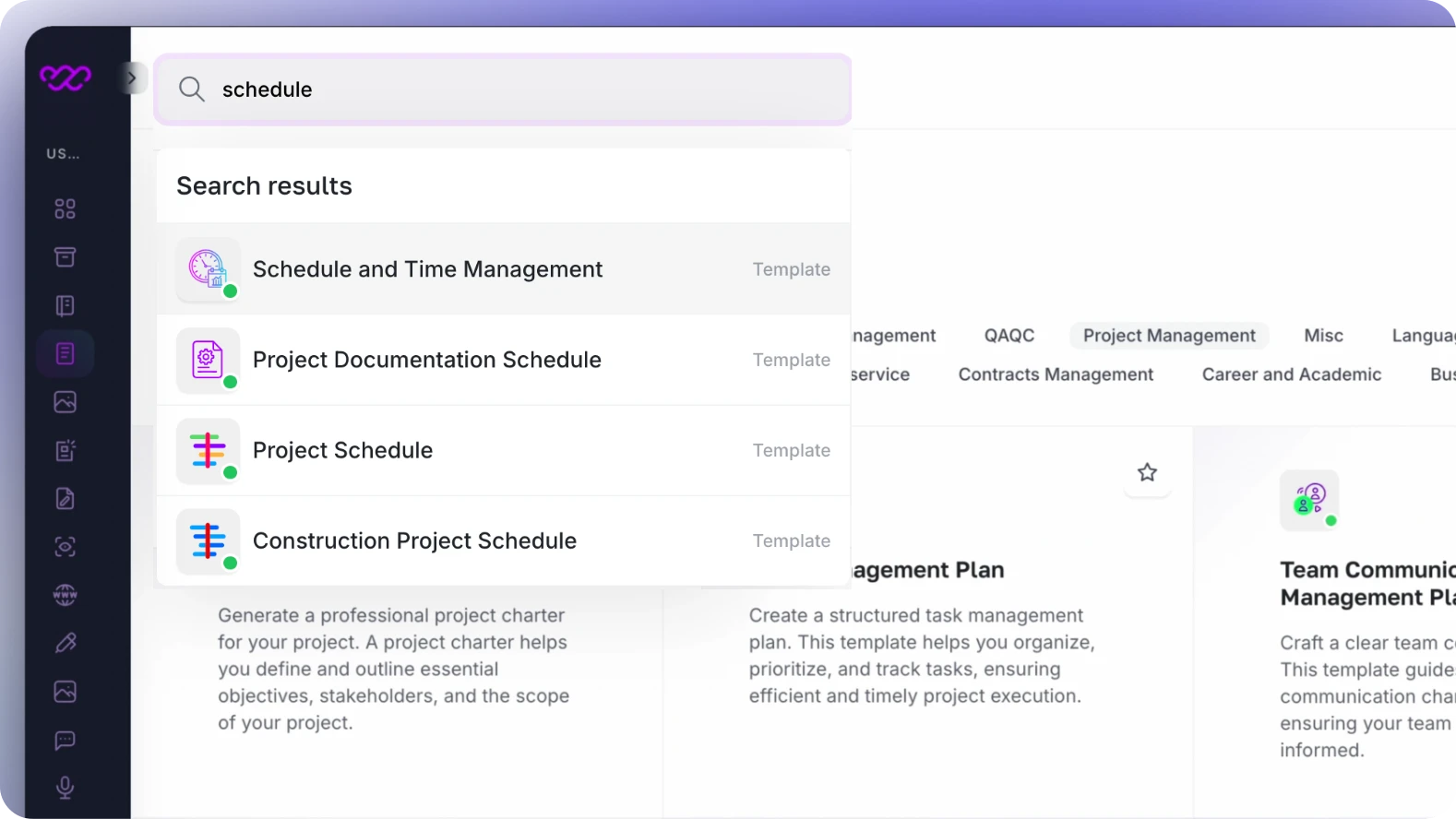
Option 1: To locate the “Project Schedule & Time Management Plan” tool, navigate to the search box on top of the WriteGenic AI dashboard. Type in the name of the tool you are looking for, and it will be displayed there. Simply click on it to launch it.
Option 2: Alternatively, navigate to the left navigation menu, click “AI Writer,” and select the “Project Management” category of templates. Scroll down to the “Project Schedule & Time Management Plan“.
Step 2: Enter The Project Specific Information
The second step is to enter the necessary project details such as Project Tasks, Timeline, Dependencies, and Estimated Critical Path details as given below:
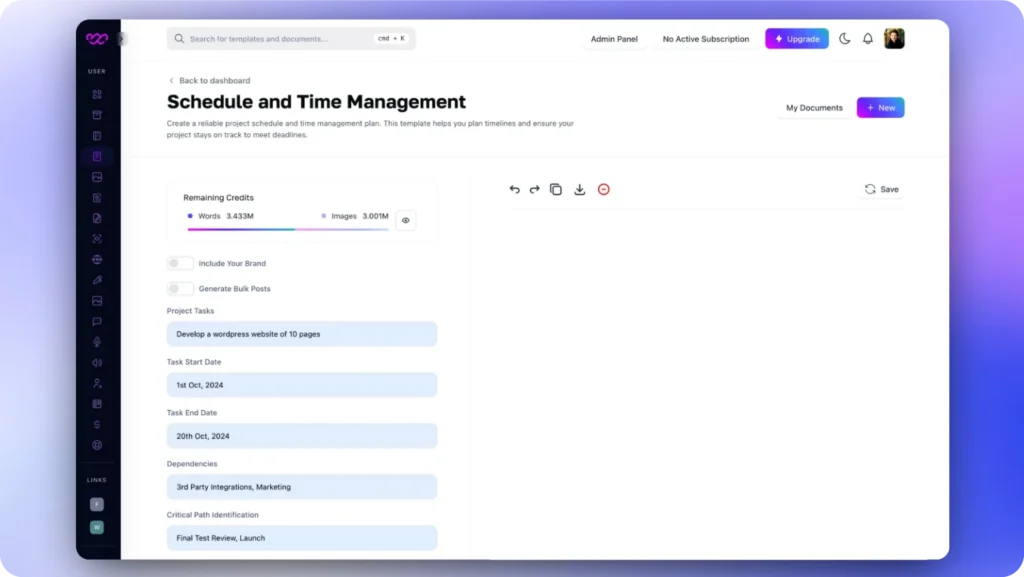
Make sure you have entered as much information as you can to make the document perfect and specific to your project or business.
Step 3: Generate the Document
After entering all the necessary information, just click on the Generate button, and WriteGenic AI will automatically create your personalized Project Schedule & Time Management Plan within a few seconds.
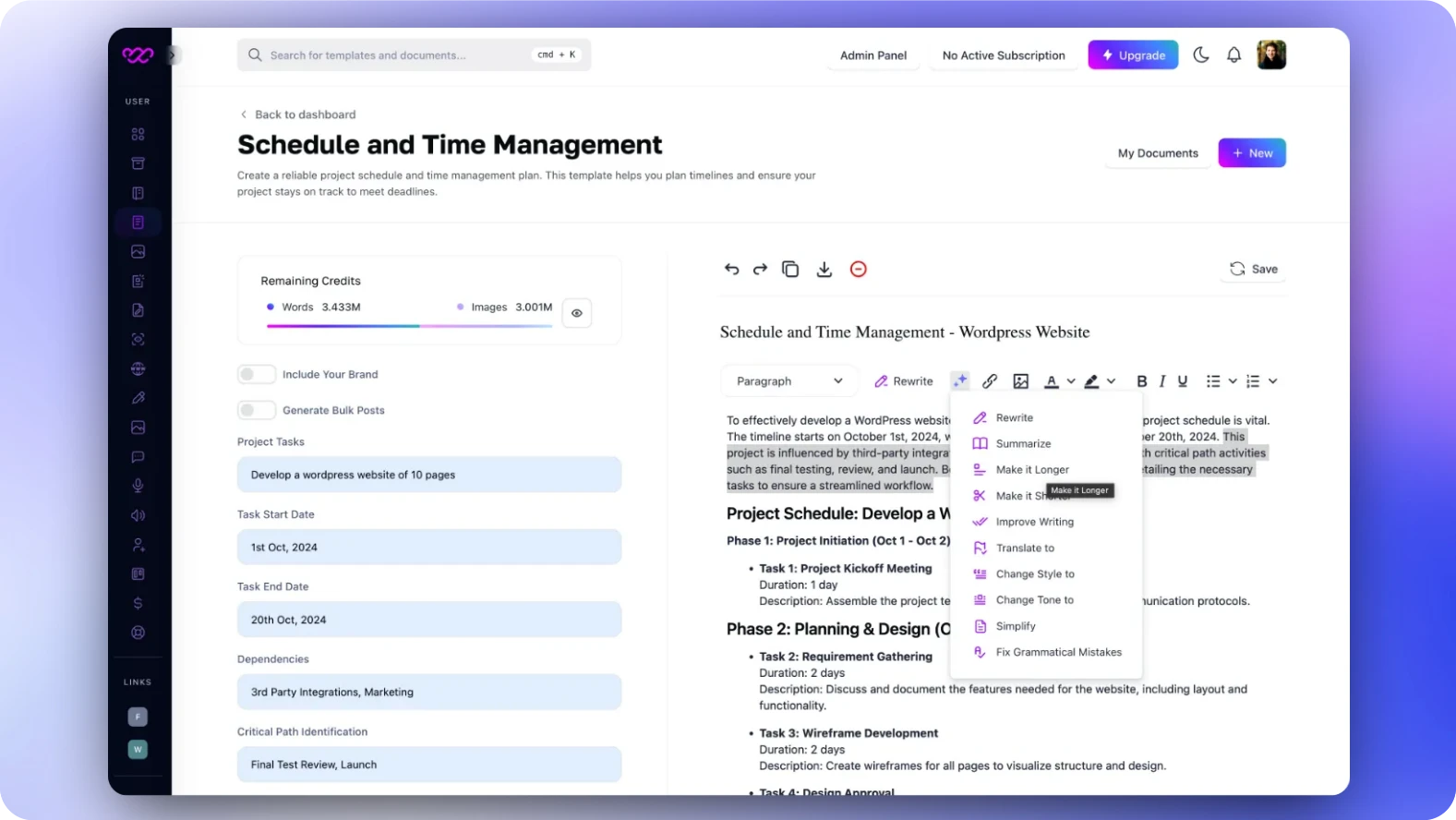
This document is required during the planning phase of the project. However, Writegenic AI also generates a draft project schedule for your project within no time.
With Writegenic AI,
See it in action!
Benefits of Good Time Management in Project Management
1. Improved Project Schedules and Efficiency
Project Schedule and time management directly enhances project timelines by eliminating delays and enhancing productivity. Teams are better at achieving their goals if they adhere to structured schedules, which can offer a point of reference.
With better timelines, you can also allocate resources better, allowing your team to focus on quality without overworking.
2. Enhanced Resource Utilisation and Cost Efficiency
By effective project schedule and time management techniques, project teams can optimize the use of resources, waste none, and attain maximum cost-effectiveness.
Project budgets are directly impacted by resource conservation, thereby allowing effective money management and even releasing funds for future projects or upgrades.
Enhanced Teamwork and Coordination
Effective time and schedule management offers a good platform for enhanced teamwork among team members because effective roles and dedicated time frames facilitate communication.
Such collaborative culture not only improves performance at the team level but also creates job satisfaction that can stretch its benefits to the result of a project.

Reduced Stress Levels and Improved Work-Life Balance
Regular project schedules lead to reduced levels of stress among members because they understand their responsibility and deadlines thoroughly. Improved project schedule and time management enables improved work-life balance, which empowers members to define office hours and other time outside it.
A healthy workload can boost morale and tenure, which can have a positive impact on project continuity and performance.
Improved Customer and Stakeholder Satisfaction
Effectively, project schedule and time management means greater customer and stakeholder satisfaction. Delivering projects on time, within budget, and to the prescribed quality earns trust and rapport with clients and stakeholders.
Satisfied customers can translate into repeat business and word-of-mouth referrals, which are worth their weight in gold when it comes to drumming up future projects and business growth.
FAQs: The Ultimate Guide to Effective Project Schedule and Time Management
What is Project scheduling: ?
Project scheduling is the process of specifying all the tasks, timelines, and resource allocations for a project to be delivered on time.
Why is project time management so important?
Time management is important because it reduces costs, enhances productivity, and improves the likelihood of meeting project deadlines.
How do I create a project schedule?
Start by defining your project goals, breaking down the work, estimating resources and time, then assemble it all into a timeline.
What are some tools for project time management?
Tools like Asana, Trello, and Microsoft Project contain scheduling, task management, and team collaboration features.
What is the 80/20 rule of project management?
The 80/20 rule suggests that 80% of results come from 20% of effort; focusing on influential activity can yield a massive reward.
How do I improve team communication?
Use communication channels and hold regular check-ins to ensure that everybody is on the same page about project goals and progress.
What are successful time management advantages?
Advantages are greater productivity, more efficient resource utilization, improved cooperation, reduced stress, and higher customer and stakeholder satisfaction.
How do I adapt to changes in project deadlines?
Be adaptable, develop contingency plans, and maintain open lines of communication with your team.
Why is resource estimating important?
Accurate resource estimation prevents bottlenecks and gives team members what they need to carry out functions efficiently.
When should I review the project schedule?
Review the schedule at regular intervals throughout the project life cycle, especially at key milestones or whenever changes occur.
Final Thoughts
Mastering the art of project schedule and time management and schedule is paramount to anyone working on project delivery. By understanding the basics, the subtleties of the scheduling process, and best management practices, you set your project up for success. Well beyond merely meeting a deadline, sound time management optimizes teamwork and increases overall satisfaction, making it an essential part of a winning project culture.
When you begin your project management career, keep these observations in mind and apply them to your situation. With time and practice, you’ll be better, streamline your processes, and drive your projects to new heights. Project management is not just about meeting deadlines; it’s about creating a system where each individual works their best—and that starts with efficient scheduling and time management.
With Writegenic AI,
Create any document in less than 5 minutes!